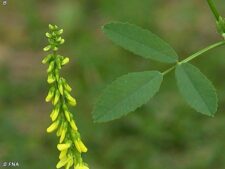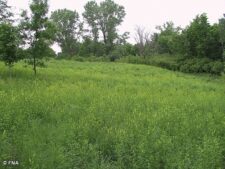
YELLOW SWEET CLOVER
Melilotus officinalis
BEAN FAMILY (Fabaceae)
 Identification
Identification
- Flowering time - May, June, July, August, September, October
- Common in disturbed areas at both FF and NW
- Elongated clusters of small, yellow pea-like flowers
- Leaflets in groups of 3
This naturalized annual or biennial was introduced from Eurasia as a forage plant and quickly escaped into the wild. The loosely branched plant grows up to 5 feet tall (A). The compound leaves have three oblong leaflets (B). The tiny yellow pea-like flowers are arranged in an elongated cluster (raceme) borne from the leaf axils.
Found along roadsides and fields, flowering from May through October. It favors disturbed sites, but can be a nuisance plant in prairie restorations, populations often exploding after a burn as the photo of Nebraska Prairie at Neale Woods illustrates (C).
Yellow Sweet Clover usually begins flowering a week or two earlier than White Sweet Clover (Melilotus alba). Otherwise the two are very similar except for the color of the flowers. In fact, they have at times been classified as simple color variants of the same species.
The content of NatureSearch is provided by dedicated volunteer Naturalists of Fontenelle Forest who strive to provide the most accurate information available. Contributors of the images retain their copyrights. The point of contact for this page is: Roland Barth.


